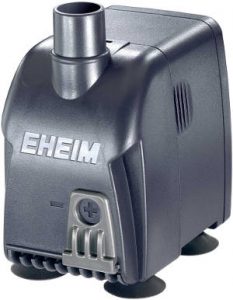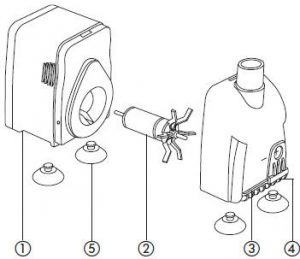
View On Amazon
| GPH | Dimensions | Max Head | Noise Level | Longevity | Price |
| 264 GPH | 2.12″ x 3.7″ x 3.07″ | 6.5′ | Very Low | 3-6 Years | Medium-high |
Eheim is a company I’ve trusted for well over a decade, and the Eheim Compact 1000 is no exception. The pump will move water for years, enduring constant heavy use without making a lot of noise. The price is a bit higher than I would like for this size pump, but it certainly won’t let you down.
Set-up
The Eheim 1000 Compact pump comes with the suction cups detached from the pump. This ensures that they are not warped in transit. You will need to insert all 4 suction cups into the bottom of the pump. You can then attach the pump wherever you like, so long as it is completely submerged. Running the pump while dry can damage the rotor immensely. If you partial submerge the pump and hear loud rattling it is not submerged deep enough in the water
The pump fits a 5/8″ ID tubing snuggly. The tubing is best purchased online, as I have found hardware stores overcharge dramatically. The issue this creates is that the tubing will often be tightly coiled, refusing to stay straight when set up to our systems. To remedy this you will need to stretch out the tube and apply heat. This can be done in the sun on a hard surface, with a heat gun or by filling a bathtub with hot/boiling water. You can typically find a heat gun if you ask artists, more specifically ceramics.
The suction cups are fairly strong and will even support the weight of the tubing, provided that the tubing is not pulling directly away from the glass. The cord on the Eheim 1000 compact pump measures 4.9 feet or 1.5 meters. This is more than enough wiring for indoor use, however pond owners will need to double check how much distance they need. Remember the cord is not a grounded 3 prong, so keep it safe.
Assembly

Opening the Eheim is fairly easy. The front grate on the pump will come off, bringing the front two suction cups with it. This exposes the impeller, which should be removed for cleaning. This will also allow you to clean the impellers magnetic mount. Both the impeller and mount must be cleaned using soft materials. Any scratches to these parts will cause irregular spinning, decreased water flow and shorten the life of the pump. All the parts are sold separately, and Eheim even offers the product numbers.
While cleaning out the pump be sure to check both the intake and output of the pump. The Eheim 1000 has the grate mounted on the bottom of the body, so it is hard to see build up without removing the pump. Remove the tubing to check the output as well.
Flow & Adjustments
The Eheim compact pump features a flow adjusting slider on the front of the pump. I tend to keep mine maxed, as the overflow box will always keep up with whatever flow the pump produces. For other uses however you may want to fine tune the flow.
The maximum head of 6.5 feet is more than enough for a sump or refugium. As my bedroom tanks sump does not reach this max head the pump still delivers a large flow rate.
When reaching the max head you will notice a weaker flow rate, however not as weak as many other pumps will get. If you are getting too little flow you can try moving the pump a bit closer to its final destination. The suction cups can easily hold the pump in place, so there should be no need to worry.
Warranty & Lifetime
Eheim offers a three year warranty on almost all of their products. This will easily catch any and all defective units that you could receive. Additionally this will often extend the life of first time pump owners pumps.
When uncared for and running constantly many owners see between 2-4 years of life. This means the pump will typically give out once within the warranty period, extending the overall lifetime.
When well cared for and still running constantly you can expect to see anywhere between 3 and 7 years of lifetime. Typically only a single part of the pump will break. Once isolated the part can be replaced for a much lower cost. This will typically result in a full strength pump once again.
Rouge Pumps/Reverse Siphon Warning
When moving water, or air, around in a tank via tubes you will almost always be at risk of a reverse siphon. This is when the flow stops and only gravity is acting on the water. This causes the water to fall down the tube. As the water falls it will create a suction force, pulling whatever is behind it down the tube as well. Most often this is water.
Here’s an example of how this can be dangerous: Your display tank holds 60 gallons of water while your sump holds 20 gallons of water, but is only filled up to 15 gallons. This gives you some leeway for water evaporation. However the pump stops working, and its tube, which is submerged in the display tank, now starts pulling water into the sump. If this tube is half way into the tank it will try and pull out 30 gallons of water. Fitting 45 gallons in a 20 gallon tank simply isn’t going to happen.
This will result in flooding, which can cause all sorts of home damage. To prevent this you will either need to:
A.) Not submerge the tube
B.) create a hole in the tube just above the waters surface
The hole just above the waters surface is how I do things, as it still puts the water directly into the tank without creating any loud splashing sounds. The hole allows the reverse siphon to pull in air rather than water. This rapid decrease in pressure causes only the water in the tube to drain into the sump and ends the siphon. Just be sure to test your hole, as mine didn’t work until I made it a bit bigger than expected.
Looking for more information on quiet aquarium water pumps? Read our full guide here.